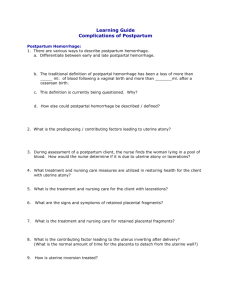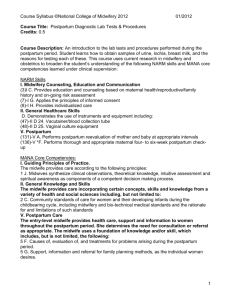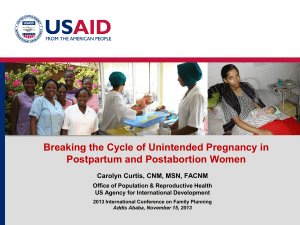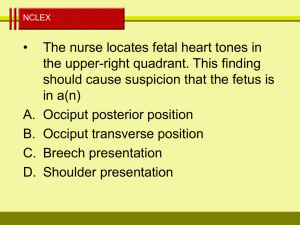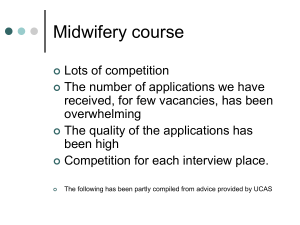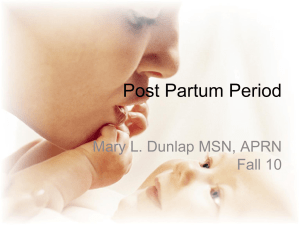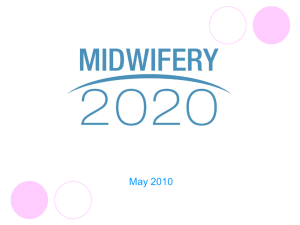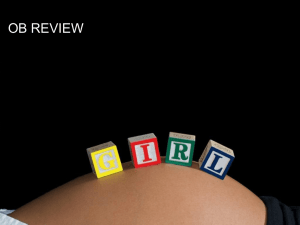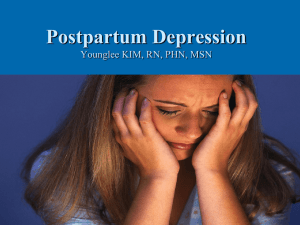Course Title: Postpartum Complications
advertisement
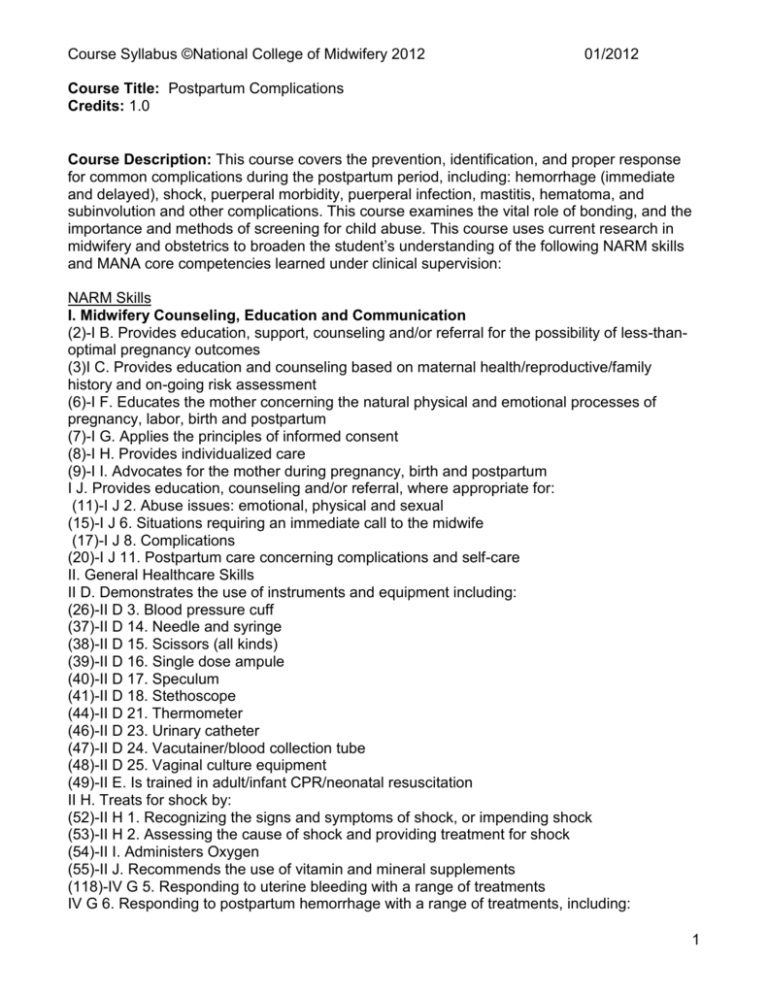
Course Syllabus ©National College of Midwifery 2012 01/2012 Course Title: Postpartum Complications Credits: 1.0 Course Description: This course covers the prevention, identification, and proper response for common complications during the postpartum period, including: hemorrhage (immediate and delayed), shock, puerperal morbidity, puerperal infection, mastitis, hematoma, and subinvolution and other complications. This course examines the vital role of bonding, and the importance and methods of screening for child abuse. This course uses current research in midwifery and obstetrics to broaden the student’s understanding of the following NARM skills and MANA core competencies learned under clinical supervision: NARM Skills I. Midwifery Counseling, Education and Communication (2)-I B. Provides education, support, counseling and/or referral for the possibility of less-thanoptimal pregnancy outcomes (3)I C. Provides education and counseling based on maternal health/reproductive/family history and on-going risk assessment (6)-I F. Educates the mother concerning the natural physical and emotional processes of pregnancy, labor, birth and postpartum (7)-I G. Applies the principles of informed consent (8)-I H. Provides individualized care (9)-I I. Advocates for the mother during pregnancy, birth and postpartum I J. Provides education, counseling and/or referral, where appropriate for: (11)-I J 2. Abuse issues: emotional, physical and sexual (15)-I J 6. Situations requiring an immediate call to the midwife (17)-I J 8. Complications (20)-I J 11. Postpartum care concerning complications and self-care II. General Healthcare Skills II D. Demonstrates the use of instruments and equipment including: (26)-II D 3. Blood pressure cuff (37)-II D 14. Needle and syringe (38)-II D 15. Scissors (all kinds) (39)-II D 16. Single dose ampule (40)-II D 17. Speculum (41)-II D 18. Stethoscope (44)-II D 21. Thermometer (46)-II D 23. Urinary catheter (47)-II D 24. Vacutainer/blood collection tube (48)-II D 25. Vaginal culture equipment (49)-II E. Is trained in adult/infant CPR/neonatal resuscitation II H. Treats for shock by: (52)-II H 1. Recognizing the signs and symptoms of shock, or impending shock (53)-II H 2. Assessing the cause of shock and providing treatment for shock (54)-II I. Administers Oxygen (55)-II J. Recommends the use of vitamin and mineral supplements (118)-IV G 5. Responding to uterine bleeding with a range of treatments IV G 6. Responding to postpartum hemorrhage with a range of treatments, including: 1 Course Syllabus ©National College of Midwifery 2012 01/2012 (119)-IV G 6 a) Administration of medication (120)-IV G 6 b) Administration of oxygen (121)-IV G 6 c) Administration of intravenous fluids or appropriate referral for intravenous fluids (122)-IV G 6 d) Treatment for shock (123)-IV G 7. Manually removing placenta fragments and/or retained membranes with a sterile, gloved hand (124)-IV H. Assesses general condition of mother and newborn by a variety of criteria (125)-IV I. Performs catheterization when needed V. Postpartum (138)-V H. Knows treatments for mastitis MANA Core Competencies: I. Guiding Principles of Practice. The midwife provides care according to the following principles: 1 C. Midwives work as autonomous practitioners, collaborating with other health and social service providers when necessary. 1 K. Midwives value continuity of care throughout the childbearing cycle and strive to maintain continuous care within realistic limits. 1 L. Midwives understand that the parameters of “normal” vary widely and recognize that each pregnancy and birth is unique. II. General Knowledge and Skills The midwife provides care incorporating certain concepts, skills and knowledge from a variety of health and social sciences including, but not limited to: 2 C. Community standards of care for women and their developing infants during the childbearing cycle, including midwifery and bio-technical medical standards and the rationale for and limitations of such standards 2 J. The grieving process. 2 M. The ability to develop, implement and evaluate an individualized plan for midwifery care. 2 N. Woman-centered care, including the relationship between the mother, infant and their larger support community. 2 O. Knowledge and application of various healthcare modalities as they apply to the childbearing cycle IV. Care During Labor, Birth and Immediately Thereafter The midwife provides health care, support, and information to women throughout labor, birth and the hours immediately thereafter. She determines the need for consultation or referral as appropriate. The midwife uses a foundation of knowledge and/or skill which includes the following: 4 D. Emotional responses and their impact during labor, birth and immediately thereafter. 4 J. Causes of, evaluation of and appropriate treatment for variations which occur during the course of labor, birth and immediately thereafter. 4 K. Emergency measures and transport procedures for critical problems arising during labor, birth or immediately thereafter. 4 M. Familiarity with current bio-technical interventions and technologies, which may be commonly used in a medical setting. 4 N. Evaluation and care of the perineum and surrounding tissues. 2 Course Syllabus ©National College of Midwifery 2012 01/2012 V. Postpartum Care The entry-level midwife provides health care, support and information to women throughout the postpartum period. She determines the need for consultation or referral as appropriate. The midwife uses a foundation of knowledge and/or skill, which includes, but is not limited, the following: 5 B. Lactation support and appropriate breast care including evaluation of, identification of and treatments for problems with nursing. 5 C. Parameters and methods for evaluating and promoting maternal well-being during the postpartum period. 5 F. Causes of, evaluation of, and treatments for problems arising during the postpartum period. Learning Activities: A. Student reads appropriate sections from the Learning Materials/Resources. B. Student answers the questions listed in the Learning Objectives by researching the Learning Materials/Resources for the course and correctly cites the sources and page numbers for each of their answers. C. Student presents answers the questions listed in the Learning Objectives for review by preceptor. D. Student participates in preceptor elaboration/discussion of Learning Objectives. E. In the case that the required texts are more than 5 years old, the student must research, prepare & present a summary of current best midwifery care/practices appropriate to a topic in this course from a current journal article/study, less than 5 years old. F. Recommended Role-playing and/or Clinical Interactions Note: The clinical requirement of NARM /Clinical Skills is completed at any time throughout the ASM apprenticeship during actual clinical practice and is NOT a requirement to complete this academic course. Activities specific to NARM skills learned in this section: 1. Practice estimating blood loss using red fluids (such as tomato juice) on disposable underpads. 2. Rehearse a scenario with another student or your instructor where you would treat a mother for shock (giving oxygen, elevating legs, taking vital signs, etc.) and calling for transport. 3. If appropriate, practice starting an IV on a model or other student or your preceptor. 4. Make a flashcard with the signs and symptoms of mastitis vs. plugged duct. List possible treatments for plugged ducts on the card. List referral numbers for a physician who can treat the mastitis. List natural remedies. 3 Course Syllabus ©National College of Midwifery 2012 01/2012 5. Practice delivering a placenta on a model or talk through your steps with supervision by your instructor. 6. Discuss with your instructor the indications for and the steps in performing a bimanual compression of the uterus. 7. Talk through how you would inspect a perineum for lacerations, step by step, including maintaining sterile procedure. 8. Make a flashcard with signs and symptoms of various types of postpartum infections (Endometritis, UTI, laceration infection, thrombophlebitis.) 9. Talk through with your instructor the steps for manual removal of the placenta. 10. Talk through with your instructor the steps for intrauterine exploration for retained placental fragments. 11. Practice drawing up and giving an injection. 12. Practice on a model or talk through the steps for performing a urinary catheterization. 13. Make a handout that gives women and their partners the symptoms of postpartum depression. 14. Practice using a tool to screen for postpartum depression with another student or a client under supervision. 15. Practice adult CPR or get certified in adult CPR as a healthcare provider. Learning Materials / Resources: Please use textbooks less than 5 years old or most recent edition. 1. Gruenbert, Bonnie. Birth Emergency Skills Training: Manual for Out-of-Hospital Midwives. Birth Guru Publications. 2008. 2. Cunningham, Kenneth Leveno, Steven Bloom, and John Hauth. William’s Obstetrics. 23rd edition. McGraw-Hill Professional. 2009. 3. Fraser, DM, et al. Myles Textbook for Midwives. 15th ed. Churchill Livingstone Press. 2009 4. Tharpe, Nell and Farley, Cindy. Clinical practice guidelines for midwifery and women’s health. 3rd ed. Jones and Bartlett publishers. 2009 4 Course Syllabus ©National College of Midwifery 2012 01/2012 5. Frye, Anne. Healing Passage: A midwife’s Guide to the care and repair of the tissues involved in birth. 6th Edition. Labrys Press. 2010 6. Varney, Helen. Varney’s Midwifery. 4th Edition. Jones and Bartlett Publishers. 2004 7. MEAC Abbreviated NARM Skills Form. 8. MANA Core Competencies for Midwives 9. Midwives Model of Care®. 10. Students must find 1 article/study less than 5 years old. Recommended internet links as needed for latest developments in midwifery care: The Cochrane Collaboration EBSCO National Library of Medicine PubMed Medline SCIRUS Medscape World Health Organization Evaluation Tools / Methods: Minimum passing grade for all courses is a cumulative 80% / B-. Students and preceptors are encouraged to work together until the student masters the information. Final grade for the course is based on preceptor evaluation of the following: A. Learning Objectives count for 80-90% of the final grade. The preceptor evaluates each answer based on three elements: 1. Answers should reflect a thorough review of current literature regarding best current practices in midwifery care. 2. Each answer should be formed in the student’s own words or paraphrased from the text. The answer should be minimal, not a re-write of the entire text, but enough to show appropriate comprehension of the learning objective. 3. Student identification of sources and page numbers for each of the Learning Objectives. (Preceptor should do a random check to determine that sources cited are correctly identified.) 5 Course Syllabus ©National College of Midwifery 2012 01/2012 B. Summary of current journal article / study counts for 10% of the final grade in the case that other scholarly resources used are more than five years old. C. Exam counts for 10% of the final grade. Course credit: One Academic credit equals approximately 15 hours of formal time plus 30 hours of additional study or homework. Formal time is defined as the amount of time taken to answer the Learning Objectives to the level of 80% and to complete any learning activities to the preceptor's satisfaction, including any time spent face to face with the preceptor. Informal time includes any time spent actively reading relevant sources and textbook/s, researching Learning Objectives, and studying for examinations. Learning Objectives: A. The student must research, prepare & present a summary of an aspect of current best midwifery care/practices appropriate to the topic of the course from a current journal article/study. B. Student answers the questions below and cites the sources and page numbers. 1. Define puerperal morbidity. What is its significance? 2. Define the blood loss that constitutes a postpartum hemorrhage. Explain how this is relative to the individual. 3. Cite the most common cause of immediate postpartum hemorrhage. 4. List four other causes of postpartum hemorrhage and the etiology of each. 5. Describe at least two actions that can be taken to avoid postpartum hemorrhage and the rationale for each. 6. Describe at least three predisposing conditions to postpartum hemorrhage and explain their relationship with postpartum bleeding. 7. Describe the steps to be taken when postpartum hemorrhage is anticipated and explain the rationale for each. 8. Describe the management steps for immediate postpartum hemorrhage and give the rationale for each. 9. Discuss the circumstances under which the administration of oxytocic drugs will not resolve a postpartum hemorrhage. 10. Discuss how why bi-manual compression of the uterus can be a life-saving technique. 6 Course Syllabus ©National College of Midwifery 2012 01/2012 11. Describe the point at which postpartum hemorrhage is better managed in a hospital then at home. 12. Describe the presentation of delayed postpartum hemorrhage; discuss the management and why. 13. Explain the teaching that should be given to a woman at risk for late postpartum hemorrhage. 14. What are the signs and symptoms of hypovolemic shock? 15. What are the steps that should be taken to manage hypovolemic shock? 16. Discuss the management of a retained placenta with no associated bleeding. 17. Discuss the management of retained membranes with no associated bleeding. 18. Discuss the management of retained clots postpartum. 19. Discuss abnormal implantation of the placenta. How can this effect the immediate postpartum period and how can the midwife manage the risk? 20. Discuss uterine inversion. Describe the varying degrees to which it can happen, its causes and management. 21. What are predisposing factors of puerperal uterine infection? 22. What bacterial organisms are most often involved in puerperal infections? 23. What are the signs and symptoms of puerperal endometritis. 24. How can endometritis be managed by a midwife? 25. Discuss the signs and symptoms of septic shock. How can it be managed? 26. Describe the presentation of infection in the vulva, perineum, and/or vagina. How is this managed? 27. What predisposing factors can lead to the infection of a laceration postpartum? 28. How can infection of a laceration be prevented? 29. Describe the presentation of mastitis. 30. Discuss the management of mastitis and why. 31. What factors can predispose a mother to mastitis? 7 Course Syllabus ©National College of Midwifery 2012 01/2012 32. What steps can the midwife take to prevent mastitis? 33. What is infectious thrombophlebitis and how is it caused? 34. Describe the presentation of non-infectious thrombophlebitis. 35. Discuss how thrombophlebitis is related to pulmonary embolism. 36. Discuss the management of thrombophlebitis. 37. Describe the presentation of a hematoma in the perineum. How can the midwife best manage this? 38. Where are the most common areas in which a postpartum hematoma might occur? 39. List the arteries most commonly involved in the formation of hematomas? 40. What are the dangers associated with a hematoma? 41. How can a hematoma be related to the inadequate repair of a laceration? 42. Explain why blood loss is always considerably more than the clinical estimate in vulvar hematomas requiring surgical repair. 43. Describe the best treatment if the hematoma is small. 44. Describe the conditions under which laparotomy is advisable when treating hematomas 45. Describe the presentation of subinvolution; discuss the management and why. 46. Discuss signs and symptoms of urethral trauma after birth. How is this managed? 47. Discuss cervical lacerations. When is it important to inspect the cervix for tears? 48. Discuss complications that can occur as a result of a 3rd and 4th degree tears. 49. Explain how bonding of the mother to the infant affects infant survival and why. 50. Discuss the characteristics of potential child abusers and why. 51. Discuss the management for potential and actual child abuse and why. 52. Discuss the principles of cardiopulmonary resuscitation of the mother. When would these actions be necessary postpartum? 53. Discuss reasons for transport of the mother during the immediate postpartum period. 8 Course Syllabus ©National College of Midwifery 2012 01/2012 54. Discuss a transport plan for a mother unable to walk on her own. 55. Discuss a scenario in which it is safer to activate EMS (Emergency Medical Services) for transport then transport independently. 56. Discuss signs and symptoms of postpartum psychosis. Differentiate between postpartum psychosis and postpartum obsessive-compulsive disorder. 57. Describe the difference between “baby blues” and postpartum depression that requires intervention. 58. What are the risks of unmanaged postpartum depression? 59. What factors can predispose a mother to postpartum depression? 9
